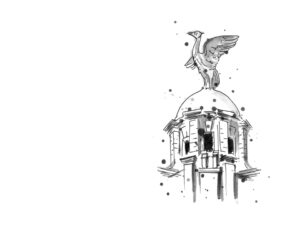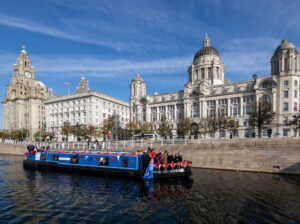
Festivals have annual cycles. Programming 10 days each year provides a certain framework that needs to be observed to ensure activities are covered; deadlines are met and agreements have been made.
People are messy. The work we generate and structures we impose often have messy edges. We create borders that are not always easy to understand; that overlap and place pressures on spots we didn’t anticipate. This happens in families, friendships and society and it’s echoed in land-war, politics and regulation. These liminal spaces are points of exchange; sometimes causing friction, sometimes creative reaction and response. In exploring such crossovers, we can learn about our existence and behaviours; we can understand past struggles and consider frayed remains.
Working outside annual cycles allows us to build long-term relationships, consider larger story arcs and dig deep with our artists. This is an example of how we sometimes begin.
Dr Paula McClosky and Dr Sam Vardy approached the Festival in March 2021. Since then, we have been talking, experimenting and devising; getting to know one another and developing ideas about embodiment, space and participation. We have connected through the Cultural Connectedness Exchange -a network for Irish and Northern Irish artist representation and commissioning- as well conversations about shifting histories, lived experiences and projects. Some ideas arrive in an instant; others take time to nurture and grow before something can be made visible. This is a behind-the-scene view on a project we hope to continue sharing as it evolves.
a place of their own
The Border in Ireland: Eile and the Liverpool Irish Famine Trail
We are a place of their own, an artist duo who have been working on the border in Ireland for many years. In 2016 we started the Eile Project or just Eile (meaning ‘other’ in Irish).
For the 2022 Liverpool Irish Festival, we will bring Eile to lead a public performance walk and discussion along the sites of the Liverpool Irish Famine Trail, which the Festival is working on regenerating (see more here: liverpoolirishfestival.com/engage/liverpool- irish-famine-trail)
Eile
Eile refers to a fictional character performed by Paula. Eile is a border creature (a gorgon, a transmuter, a witch, a shapeshifter, a banshee), summoned to perform site-specific acts across different border sites. As with the challenging nature of Nuala Ní Dhomhnaill’s work (a leading Irish poet), Eile questions the colonisation of Ireland and the subsequent emergence of patriarchal Irish myths. Eile is -if you like- about creating a new feminine-border-myth.
The whole premise of Eile is based on lived experiences of the border. Paula’s family is from the border town of Ballyshannon, Co Donegal in the Irish Republic. Significantly, her dad is Catholic and her mum Protestant. Her parents met as teenagers and moved to Dublin to be married. Paula was born in the mid-70s. Like many Irish people, Paula’s parents emigrated to the UK when she was still a young child. They ended up in the midlands, but school holidays were spent in Ballyshannon, staying with Paula’s Catholic grandmother. The trips “home” were always by car. As these were taken at the height of the so-called “Troubles”, army checkpoints and watch towers signalled they were soon to arrive in Ballyshannon.
So much of this work in Ireland is about looking at the complex histories by being on the land, performing with the landscape. We are therefore developing proposals for a public performance walk and discussions along the route and at sites on the Famine Trail in Liverpool in October 2022. The walk and talks will enable participants to think and talk about different kinds of borders, not just the geopolitical one(s) on the island of Ireland.
Through the performative act of connecting with specific locations, and responding to their stimuli, participants will learn about the what the stories of the Famine can tell us about the Irish/British relationship. Doing this whilst moving through the city, experiencing (un)familiar places in Liverpool, shares the histories of the sites of the famine trail.
About
“a place, of their own is the art and spatial research practice of Paula McCloskey and Sam Vardy, through which we interrogate and propose within entanglements of climate, capital, technology and politics. We operate as a collective, a couple, with our children, and through collaborations with others”.
Their work has been shown in Ireland, Europe, the UK and USA, and was included in the Asia-Europe Foundation culture360 Creative Responses to Sustainability UK Green Guide 2021. The Festival hopes to work with a place of their own to create site-specific experiences along the route of the Liverpool Irish Famine Trail, as it regenerates the Great Hunger Commemoration Committee’s 1990s Trail (more on page 3) to produce an accessible, resonant and important historic asset.






